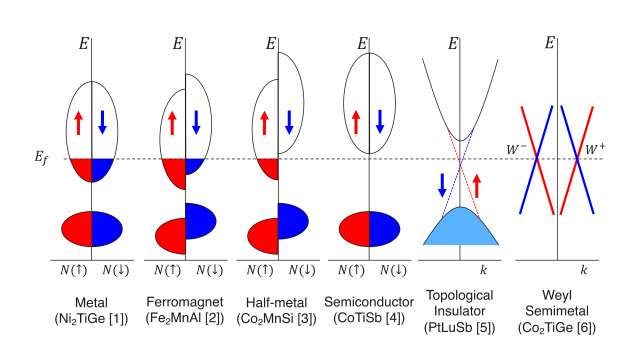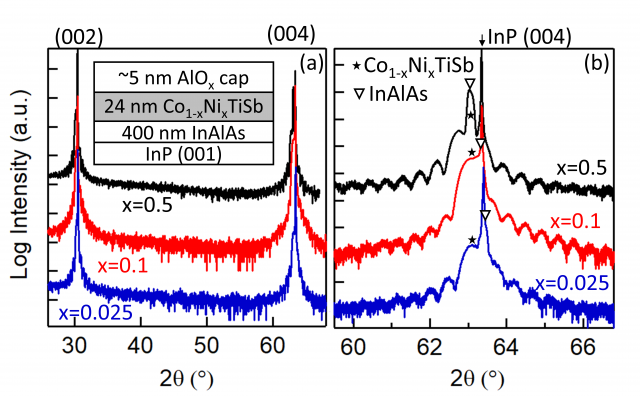
Heusler Alloys
The Heusler compounds are an exciting class of intermetallics due to their ability to adopt a wide range of tunable electrical and magnetic properties, including metallicity, half-metallic ferromagnetism, superconductivity, and narrow and wide bandgap semiconducting behavior with large thermoelectric power factors. Additionally, some of the Heuslers are predicted to be topological insulators and Weyl Semi-metals, making this family a candidate system for creating multifunctional topological heterostructures and exploring the new physics that emerges at their interfaces.
Magnetic and Half-Metals Heuslers
Heusler intermetallics show magnetic phases (ferromagnetic, antiferromagnetic, fully compensated ferrimagnetism) that the constituent atoms cannot. The alloys usually follow the Slater-Pauling rule, where the total valence electrons per formula unit directly predicts the spin magnetic moment per formula unit. Heusler alloys also form a prominent class of half-metals (where one spin channel is conducting and the other insulating/semiconducting) and spin-gapless semiconductors. These properties are retained at remarkably high temperatures, and thus Heuslers are being investigated for a variety of spintronic applications.
Relevant Publications
Near-half-metallic state in the half-Heusler PtMnSb film on a III-V substrate
Formation of Mn-rich interfacial phases in Co2FexMn1-xSi thin films
Oxygen migration in epitaxial CoFe/MgO/Co2MnSi magnetic tunnel junctions
Topologically Non-Trivial Heuslers
Recently Heuslers have been essential to the study of topologically significant materials due to their tunability. By substitution, different hybridization, spin-orbit coupling strength, and symmetries may be explored. This serves as an interesting testbed of the physics underlying these topological phases (such as topological insulators and Weyl semimetals). These properties can then be enhanced for novel control of material properties for future device structures.
We grow never before synthesized materials and characterize them extensively via our suite of in-situ techniques. During growth and post-processing we tailor these properties by epitaxial strain, doping, electrostatic gating, and symmetry. Our vacuum suitcase allows us to bring surface sensitive materials to ARPES beamlines to fully study their topology.
Relevant Publications
Defect engineering and Fermi-level tuning in half-Heusler topological semimetals
Observation of a topologically non-trivial surface state in half-Heusler PtLuSb (001) thin films
Growth, structural, and magnetic properties of single-crystal full-Heusler Co2TiGe thin films

Semiconducting Heuslers
A not so obvious feature of half-Heusler alloys is that those containing either 8 or 18 valence electrons per primitive unit cell tend to be semiconductors despite being composed of metallic elements. These closed shell electron arrangements (eg. d10 + s2 + p6 = 18) enable a semiconducting gap to open between the bonding and antibonding states. The rule of 18 allows for covalent hybridization of the transition elements; however, the Z element plays a critical role in not only supporting the hybridized bonding with the transition metals but in accommodating the extra d electrons necessary to stabilize the system. The small band gap semiconducting nature of the half-Heuslers and the vast compositional variations that are possible has spawned a great deal of interest in exploiting these material properties for thermoelectrics and infrared communication. Alloying these materials allows for studies of the metal-to-insulator transition.
Relevant Publications
Surface Reconstructions of Heusler Compounds in the Ni-Ti-Sn (001) System